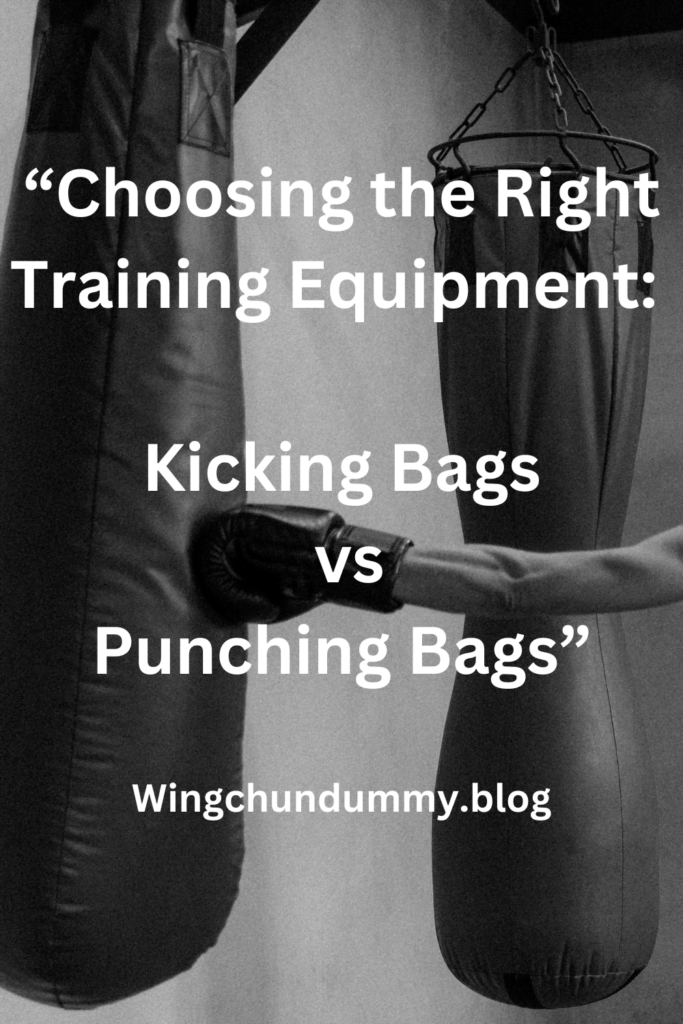Two of the most common pieces of training gear are Kicking Bags V’S Punching Bags.
When it comes to training in martial arts, boxing, or any combat sport, having the right equipment is essential.
While they may seem similar at first glance.
There are several key differences between the two that make them suitable for different types of training and techniques.
Construction and Design
One of the primary differences between kicking bags and punching bags lies in their construction and design.
Punching bags are typically cylindrical in shape and are filled with dense materials such as sand, cloth, or synthetic fibers.
They are designed to withstand repeated punches.
And are often hung from the ceiling or a stand.
In contrast, kicking bags, also known as heavy bags.
Or Muay Thai bags, are longer and heavier than punching bags.
They are cylindrical in shape like punching bags but are longer to accommodate kicks.
Kicking bags are filled with a softer material at the top to absorb the impact of kicks.
While the bottom is filled with denser material to provide stability.
Usage and Techniques
Another significant difference between Kicking Bags V’S Punching Bags bags is their intended usage and the techniques they are designed to accommodate.
Punching bags are primarily used for practicing punches, jabs, hooks, and uppercuts.
They are ideal for improving hand speed, power, and accuracy in striking techniques commonly used in boxing and martial arts such as karate and taekwondo.
On the other hand, kicking bags are specifically designed to withstand powerful kicks and knee strikes.

They are essential for practitioners of Muay Thai, kickboxing, and mixed martial arts (MMA) to develop kicking techniques, footwork, and overall lower body strength.
Kicking bags allow athletes to practice a wide range of kicks, including roundhouse kicks, front kicks, side kicks, and more.
Training Objectives
Kicking Bags V’S Punching Bags
While both kicking bags and punching bags are valuable training tools, they serve different training objectives.
Punching bags are excellent for improving cardiovascular fitness, endurance, and overall upper body strength.
They also help athletes work on their striking accuracy and precision, making them indispensable for boxers and martial artists who rely on hand strikes.
Kicking bags, on the other hand, are essential for developing lower body strength, flexibility, and kicking power.
They allow athletes to simulate real-life combat scenarios, where the use of kicks is crucial for creating distance from an opponent or delivering powerful strikes.
Training with kicking bags also helps improve balance, coordination, and agility.
Making them an integral part of any comprehensive martial arts or combat sports training regimen.
In conclusion, while both kicking bags and punching bags are valuable tools for training in martial arts and combat sports.
Their differences in construction, usage, techniques, and training objectives make them suitable for distinct training purposes.
Whether you are focused on enhancing your striking abilities or developing powerful kicking techniques.
Choosing the right training equipment that aligns with your training goals is essential for achieving success in your chosen discipline.
Training Differences and Benefits
The distinct construction and usage of kicking bags and punching bags also lead to different training approaches and benefits.
When training with a punching bag, the focus is typically on developing upper body strength, hand-eye coordination, and the precision of punching techniques.
Punching bags can also be used for cardio-intensive workouts, helping to improve endurance and cardiovascular fitness.
In contrast, training with a kicking bag emphasizes the development of lower body strength, flexibility, and the fluidity of kicking techniques.
Kicking bags allow practitioners to practice complex kicking combinations, work on their balance and footwork.
And build the muscular endurance required for sustained kicking power.

Additionally, the dynamic nature of kicking bag training can help improve overall athleticism and agility.
Ultimately, both kicking bags and punching bags play important roles in the training regimens of various combat sports and martial arts.
By incorporating both types of training equipment, athletes can develop a well-rounded skill set and physical conditioning that can give them a competitive edge in their respective disciplines.
Versatility and Adaptability
Beyond the distinct construction and training benefits, kicking bags and punching bags also differ in terms of their versatility and adaptability.
Punching bags are relatively straightforward in their usage, as they are primarily designed for practicing hand-based strikes.

While some variations exist, such as double-end bags or heavy-duty punching bags, the core functionality of a punching bag remains largely the same.
On the other hand, kicking bags offer a higher degree of versatility and adaptability.
In addition to being used for practicing a wide range of kicking techniques, kicking bags can also be utilized for other training purposes.
For instance, some kicking bags are designed with attachments or features that allow for the incorporation of other training tools, such as resistance bands or striking pads.
This versatility makes kicking bags a valuable asset for practitioners who want to diversify their training and target specific areas of improvement.
Moreover, the longer and heavier design of kicking bags makes them suitable for various training scenarios.
They can be used for drilling solo techniques, engaging in partner drills, or even as part of dynamic circuit training routines.
This adaptability allows kicking bag training to be tailored to the specific needs and goals of individual athletes, making it a valuable tool for a wide range of martial arts and combat sports.
Choosing Your
Kicking Bags V’S Punching Bags
When it comes to selecting the appropriate training equipment, the choice between Kicking Bags V’S Punching Bags ultimately depends on the specific needs and goals of the athlete or practitioner.
If the primary focus is on developing hand-based striking skills, such as in boxing or certain karate styles.
A punching bag may be the more suitable option.
On the other hand, if the training emphasis is on developing kicking techniques and overall lower body power.
A kicking bag would be the more appropriate choice.
This is particularly true for practitioners of Muay Thai, kickboxing, or mixed martial arts.
Where the ability to execute powerful and diverse kicks is essential.
It’s also important to consider the available space and the training environment.
Kicking bags tend to be larger and heavier than punching bags.
So they may require more dedicated space and sturdy mounting systems.
Additionally, the impact of kicking can be more demanding on the training area.
So it’s essential to ensure that the space can accommodate the intensity of kicking bag training.
Ultimately, the decision to choose a kicking bag or a punching bag should be based on a thorough evaluation of the athlete’s training goals.
The specific martial art or combat sport being practiced, and the available training facilities.
By selecting the appropriate equipment.
Practitioners can maximize the benefits of their training and improve their overall performance in their chosen discipline.
Kicking Bags V’S Punching Bags
They can also be used in a complementary manner to create a well-rounded training program.
Many athletes and practitioners choose to incorporate both types of training equipment into their regimens, recognizing the unique benefits and adaptability they each offer.
By alternating between kicking bag and punching bag training.
Athletes can develop a more comprehensive skill set and physical conditioning.
For instance, a Muay Thai practitioner may start their training session with kicking bag work to focus on the development of their lower body techniques and power.
Followed by punching bag drills to refine their hand strikes and overall striking accuracy.
This complementary approach can also be beneficial for athletes who compete in sports that require a combination of hand-based and kick-based techniques, such as mixed martial arts.
By training with both kicking bags and punching bags.
They can ensure that they are well-prepared to execute a wide range of striking techniques during competition.
Moreover, the use of both training tools can help practitioners address any potential imbalances or weaknesses in their overall physical development.
By targeting both the upper body and lower body.
They can strive for a more balanced and well-rounded physical condition.
Which can translate to improved performance and reduced risk of injury.
In summary, while kicking bags and punching bags have their distinct differences.
They can be used in a complementary manner to create a more comprehensive and effective training program.
By incorporating both types of training equipment, athletes can develop a diverse skill set.
Also, Enhance their physical capabilities.
And better prepare themselves for the demands of their chosen martial art or combat sport.






